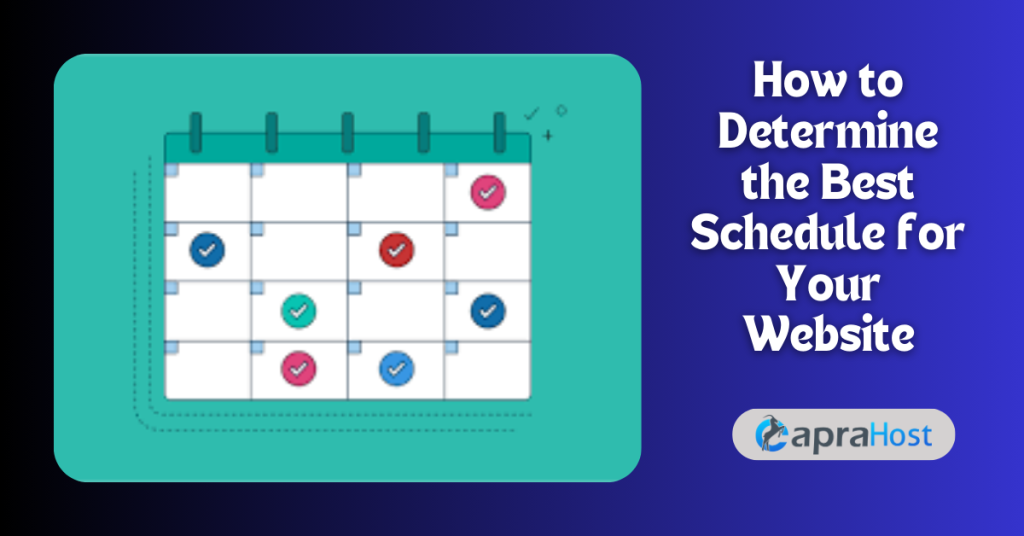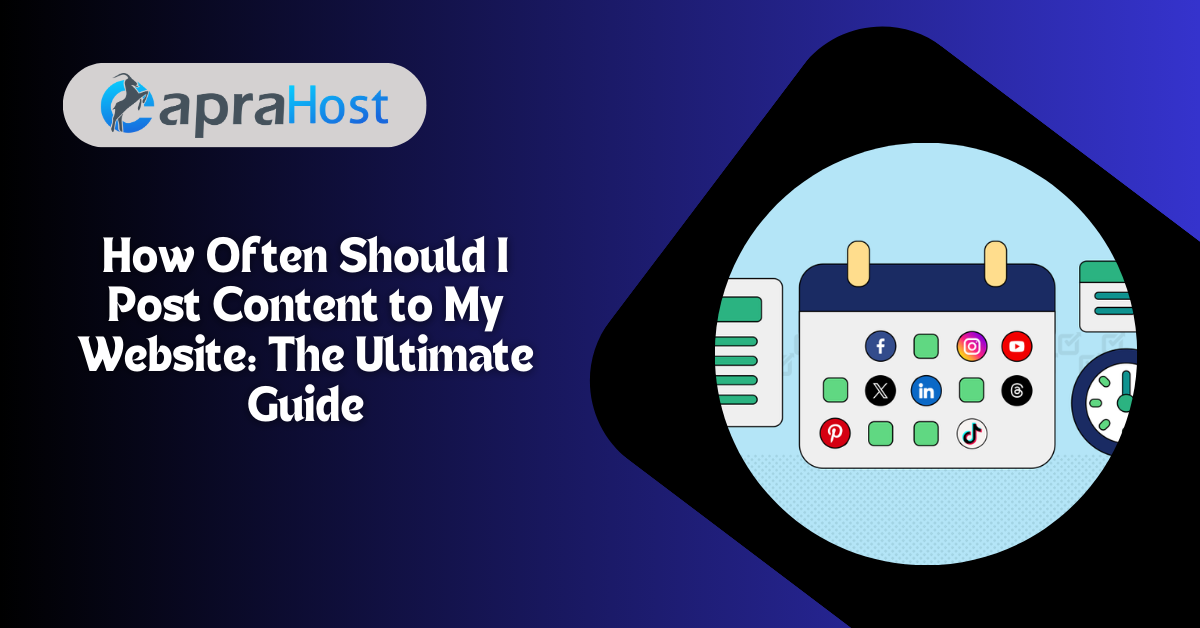Introduction To Creating A Content Strategy
Content is the backbone of any successful website. Whether you run a blog, an e-commerce site, or a corporate page, regularly publishing fresh content helps maintain audience interest, boosts SEO rankings, and builds your brand authority.
But one crucial question remains—how often should you post content?
The right posting frequency depends on several factors, including your industry, target audience, and available resources.
Posting too often can overwhelm your audience, while infrequent updates can make your website appear outdated.
In this guide from our Blog, we’ll explore the importance of How Often Should I Post Content to My Website, the key factors that influence it, and how you can determine the best schedule for your website.
Why Content Posting Frequency Matters?
In the digital age, content is king, but consistency is the key to success. Whether you run a blog, manage a business website, or handle social media accounts, your content posting frequency significantly impacts audience engagement, SEO performance, and overall brand growth.
Posting too little can lead to lost visibility, while excessive posting may overwhelm your audience. Finding the right balance is essential for sustained success.
1. Enhances Audience Engagement: Keeping Your Audience Interested
Consistent posting keeps your audience engaged and returning for more. When followers know they can expect fresh content regularly, they are more likely to interact with your brand.
For example, a blog that publishes articles weekly creates anticipation, while a social media account posting daily stays relevant in users’ feeds. A predictable schedule builds trust and encourages loyal followers.
2. Improves SEO Rankings: Boosting Your Search Visibility
Search engines prioritize websites that update their content frequently. Google, for instance, favors Fresh Content With Relevant Keywords, which means regular posting can improve your search rankings.
Websites that remain static for long periods may lose authority, leading to lower organic traffic. Moreover, more content means more opportunities for keyword optimization, increasing your chances of ranking higher in search results.
3. Increases Brand Authority and Credibility: Building Trust
A well-maintained posting schedule establishes your brand as an authority in your industry. If you consistently provide valuable insights, tips, or updates, your audience will see you as a reliable source of information.
Over time, this credibility can translate into higher conversions, customer loyalty, and thought leadership within your niche.
4. Boosts Social Media Visibility: Expanding Your Reach
Social media algorithms favor active accounts. Platforms like Facebook, Instagram, and Twitter reward frequent and consistent posting with better reach and engagement.
If you post sporadically, your content may not appear in your followers’ feeds as often, reducing its impact. On the other hand, a well-planned content calendar ensures a steady flow of updates, keeping your brand top-of-mind.
5. Supports Marketing and Sales Strategies: Driving Results
Regular content posting aligns with your marketing goals, whether you’re launching a new product, running a promotional campaign, or driving traffic to your website.
A well-structured content strategy ensures that your messaging remains consistent across multiple platforms, reinforcing your brand’s value proposition.
Finding the Right Posting Frequency
The ideal posting frequency depends on your industry, audience preferences, and content type. Here are some general guidelines:
- Blogs: 1-4 posts per week for steady traffic and engagement.
- Social media: 3-7 posts per week on platforms like Facebook and Instagram, daily posts on Twitter.
- YouTube: 1-2 videos per week for steady audience growth.
Content posting frequency plays a crucial role in building engagement, boosting SEO, enhancing brand credibility, and supporting marketing efforts. While consistency is important, quality should never be compromised.
Finding the right balance ensures that your audience remains engaged and your brand continues to grow.
Transform Your Online Presence with CapraHost! Sign Up Today!
Empower Your Website with CapraHost! Join Today and Enjoy Superior Hosting!
How Often Should I Post Content: Finding the Balance
Consistency is key when it comes to content marketing. However, determining the ideal posting frequency depends on several factors, including your industry, audience, platform, and content quality.
Below, we break down how often you should post content for maximum engagement and effectiveness.
Before deciding on a posting schedule, consider your primary objectives. Are you aiming to increase brand awareness, generate leads, or establish thought leadership? Your goals will influence your content frequency.
- Brand Awareness: Frequent posting can help keep your brand top-of-mind.
- Lead Generation: A balance of quality and quantity is necessary.
- Thought Leadership: Less frequent but high-value content can establish authority.
Ideal Posting Frequency by Platform
Each platform has different expectations for content frequency. Here are general guidelines:
Blogs
Posting 1-4 times per week is ideal for Blogs on Different Blogging Platforms. Research shows that businesses that publish 16+ blog posts per month receive 3.5 times more traffic than those publishing less frequently. However, quality should always take precedence over quantity.
Social Media
- Facebook & Instagram: 3-5 times per week
- Twitter/X: 5-10 times per day (due to fast-paced nature)
- LinkedIn: 2-5 times per week
- YouTube: 1-2 times per week
- TikTok: 3-7 times per week
These numbers can vary based on audience engagement and content type.
Quality vs. Quantity: Striking the Right Balance
While frequent posting can boost visibility, low-quality content can harm credibility. Always prioritize well-researched, engaging, and valuable content over simply meeting a quota. Consistency in tone, messaging, and value is more important than sheer volume.
Testing and Adapting: Refining Your Approach
A one-size-fits-all approach doesn’t work. Experiment with different posting frequencies and monitor engagement metrics such as:
- Website Traffic
- Social shares
- Comments and interactions
- Conversion rates
- Use this data to adjust your content strategy for optimal results.
Posting frequency should align with your business goals, available resources, and audience preferences. Whether you post daily or weekly, consistency and quality remain crucial to building a strong online presence.
Adapt based on performance analytics, and over time, you’ll find the perfect balance for your content strategy
6 Factors That Influence Posting Frequency
Determining the right posting frequency is essential for maintaining audience engagement, improving SEO, and maximizing content effectiveness. Several factors influence how often content should be published.
These include the industry and niche, audience expectations and behavior, content quality versus quantity, available resources and team size, search engine algorithms, and content distribution strategy.
Balancing these elements helps ensure that posts remain relevant, engaging, and effective in achieving marketing goals. Over-posting can overwhelm audiences, while under-posting may lead to disengagement.
The key is to find a sustainable and effective posting schedule tailored to specific business needs.
1. Industry and Niche: Tailoring to Your Sector
The industry and niche of a business play a significant role in determining posting frequency. Fast-paced industries, such as news, technology, and finance, require frequent updates to keep audiences informed about current trends.
In contrast, industries like manufacturing or B2B services may benefit from a slower posting schedule with in-depth, evergreen content.
For example, a daily news website may need multiple posts per day to remain relevant, while a luxury brand may focus on high-quality content posted less frequently to maintain exclusivity.
Understanding industry standards and competitors’ posting schedules can provide insights into the optimal posting frequency for maintaining audience engagement and industry authority.
2. Audience Expectations and Behavior: Meeting Needs
Audience behavior dictates how often content should be published. Analyzing audience engagement metrics, such as time spent on site, click-through rates, and social media interactions, helps determine the ideal posting frequency.
For example, if an audience is highly active on social media and consumes daily updates, increasing post frequency may be beneficial. Conversely, if engagement drops when posting too often, a reduced schedule may be necessary.
Understanding when and how the audience interacts with content ensures that posts are strategically scheduled to maximize visibility and impact. Surveys, analytics, and A/B testing can help fine-tune the posting strategy.
3. Content Quality vs. Quantity: Prioritizing Value
The balance between content quality and quantity is crucial in defining a posting schedule. While frequent posting increases visibility, poor-quality content can diminish credibility and engagement. Quality should always take precedence over quantity.
Creating valuable, well-researched, and engaging content takes time. Businesses must ensure that each piece of content aligns with their brand values, provides useful information, and resonates with the target audience.
If a company can maintain high quality while posting frequently, it should do so. However, if increased frequency leads to a decline in content standards, it is better to reduce posting and focus on delivering high-value material.
Related Article: High-Quality Content is the Backbone of a Winning SEO Strategy
4. Available Resources and Team Size: Managing Capacity
Posting frequency is also influenced by the resources and team size available for content creation.
Small businesses or solo entrepreneurs may struggle to produce high-quality content consistently, while larger organizations with dedicated content teams can sustain a higher posting frequency.
Factors like content planning, writing, editing, graphic design, and distribution require time and effort. If resources are limited, businesses can consider outsourcing content creation, using automation tools, or repurposing existing content to maintain a steady flow without compromising quality.
A realistic assessment of available resources ensures consistency and sustainability in content production.
5. SEO and Search Engine Algorithms: Aligning with Best Practices
Search engines favor fresh, high-quality content, making posting frequency an important factor in SEO performance.
Regular updates signal to search engines that a website is active and relevant, improving its ranking potential. However, excessive low-quality content can harm rankings.
Google’s algorithms prioritize user experience, meaning that posts should be informative, original, and engaging. Businesses should aim for a balance where they consistently publish valuable content without overwhelming their audience or reducing content quality.
Monitoring SEO performance and adjusting the posting schedule based on analytics can help optimize search visibility.
6. Content Distribution Strategy: Effective Sharing
A Strong Content Distribution Strategy ensures that content reaches the right audience at the right time. Even with a high posting frequency, content may underperform if not effectively distributed across appropriate channels.
Different platforms have varying optimal posting frequencies. For example, Twitter demands multiple daily updates, while LinkedIn and blogs benefit from less frequent, high-quality posts.
Email newsletters, social media sharing, paid promotions, and collaborations can extend content reach. Aligning posting frequency with distribution capabilities ensures maximum engagement and return on investment.
The ideal posting frequency varies based on industry, audience behavior, content quality, available resources, SEO considerations, and distribution strategy.
By carefully analyzing these factors, businesses can develop a content strategy that maximizes engagement and effectiveness while maintaining sustainability.
Regular evaluation and adjustments ensure continued success in content marketing efforts.
How to Determine the Best Schedule for Your Website?
Determining the best schedule for your website is essential to ensure consistent user engagement, optimized performance, and a smooth content delivery system.
A well-planned schedule can help you manage updates, blog posts, promotions, and system maintenance without overwhelming your team or confusing your visitors.

Here’s how you can determine the best schedule for your website:
1. Understand Your Audience’s Behavior: Insights and Analysis
The first step is understanding when your target audience is most active. Use analytics tools such as Google Analytics to track peak visitor times, where they’re coming from, and what content they engage with most.
This data will give you insights into the days and times when your audience is online, helping you schedule new content releases, product updates, or promotions accordingly.
For example, if you run an e-commerce website, knowing that your target demographic shops primarily in the evening can help you time product launches and discounts to coincide with these peak hours.
On the other hand, if you’re running a B2B website, you might want to schedule content releases during business hours when your target market is most likely engaged.
2. Content Strategy and Consistency: Staying on Track
Next, establish a Winning Content Strategy Schedule that aligns with your audience’s preferences. Whether you’re posting blogs, videos, or new product updates, consistency is key to building trust and engagement.
Define how often you will update your website, whether it’s weekly, bi-weekly, or monthly.
For blogs, for example, publishing content consistently (such as every Tuesday at noon) helps visitors know when to expect fresh content. Over time, this can become a reason for your audience to return regularly.
The same goes for email newsletters—set a regular time and day for dispatch to establish a pattern your subscribers can rely on.
3. Optimize for SEO: Maximizing Visibility
Search engine optimization (SEO) plays a vital role in determining your website’s success. Part of your content schedule should include a focus on SEO best practices.
Search engines like Google often reward websites that regularly update their content with fresh, relevant information. Regularly scheduled blog posts, product updates, or even new landing pages with keywords that are relevant to your target audience will improve your visibility.
If your website’s blog is a major source of traffic, consider having a content calendar that maps out future topics. Not only does this improve SEO, but it also allows you to plan your content in advance, which can lead to more strategic content marketing efforts.
4. Maintenance and Back-End Tasks: Keeping Things Running Smoothly
Aside from content-related schedules, there’s also the need for back-end maintenance. Regular site maintenance—such as software updates, security checks, and server optimizations—should be scheduled to minimize disruptions to your website.
For most websites, a bi-monthly or quarterly maintenance schedule is sufficient, but you should always prioritize security patches as soon as they’re available.
To avoid downtime or broken functionality, schedule maintenance during off-peak hours when traffic is lowest. You can also notify users in advance about upcoming maintenance to minimize any frustration.
5. Promotions and Marketing: Spreading the Word
Scheduling promotions and marketing campaigns around holidays, product launches, or special events should also be a part of your website’s schedule. Timing plays a crucial role in the success of these events.
Use data and industry trends to determine the best times for promotions to capture your audience’s attention.
Consider implementing timed discounts, flash sales, or limited-time offers on your website. Align these events with your content schedule to ensure that visitors don’t miss out on promotions.
Experience Flexibility and Power with CapraHost VPS! Join Today!
Maximize Your Website’s Potential with CapraHost VPS Hosting! Sign Up Now!
6. Track, Analyze, and Adjust: Continuous Improvement
Lastly, continuously track the results of your website’s schedule. Use tools like Google Analytics, A/B testing, and user feedback to assess what works and what doesn’t.
Adjust your schedule based on this feedback. For example, if a blog post on a particular topic generates more traffic than others, consider scheduling more similar content.
Determining the best schedule for your website isn’t a one-size-fits-all approach.
By understanding your audience, maintaining consistency, focusing on SEO, keeping up with back-end maintenance, and aligning marketing efforts, you can create a schedule that works for your site’s growth and keeps visitors engaged.
Regular analysis and adjustments will ensure that your website remains dynamic and responsive to changes in audience behavior, technological advancements, and business goals.
Conclusion
The best way to upload information is to be consistent, but there is no one-size-fits-all solution. Make sure your material is consistently of the highest caliber and useful to your readers regardless of how frequently you publish—daily, weekly, or monthly.
You may strike the ideal balance between frequency and quality by examining the data from your website, taking your industry into account, and experimenting with various approaches.
To optimize the success of your website, follow a plan, track your progress, and make any adjustments.
We take no shortcuts when it comes to hosting. CapraHost provides affordable, high-performance web hosting. Top features like cache, backups, and SSL certificates are included as standard in our web hosting plans.
For faster page loads, we always employ high-end hardware. With our risk-free money-back guarantee and round-the-clock in-house customer service, get started right now.
FAQs (Frequently Asked Questions)
1: How often should I post new content to my website?
The ideal posting frequency depends on your website’s goals, audience, and industry. For blogs and news sites, posting 3–5 times per week can help maintain high engagement and SEO rankings.
Business websites focusing on thought leadership or services may find that 1–2 high-quality posts per week are sufficient. The key is consistency—whether it’s daily, weekly, or biweekly, maintaining a schedule helps search engines recognize your site as active and authoritative.
2: Does posting more frequently improve SEO rankings?
Yes, frequent content updates can improve your search engine rankings, but quality is more important than quantity. Search engines like Google prioritize fresh, valuable, and well-optimized content.
If you post frequently but with poor-quality articles, it could harm your rankings. Instead, focus on publishing well-researched, engaging, and keyword-optimized content regularly to boost SEO.
3: How does posting frequency affect audience engagement?
Regular posting keeps your audience engaged and returning to your website. However, if you post too often, you may overwhelm readers, while infrequent posting may make them lose interest.
To determine the right balance, analyze your audience’s behavior using analytics tools. If engagement drops due to excessive posting, reduce the frequency and focus on high-quality, relevant content.
4: What type of content should I prioritize when posting?
Prioritize content that aligns with your audience’s needs and business goals. This can include:
- Blog posts for educational or informative content
- Case studies and testimonials to build credibility
- Video content for better engagement
- Infographics for visually appealing information
- Guides and tutorials to position your brand as an authority
By diversifying content types, you can keep your audience interested while maintaining a sustainable posting schedule.
5: Should I follow a strict content calendar?
Yes, having a content calendar ensures consistency and strategic planning. A well-structured calendar helps you:
- Plan content around key dates, events, and trends
- Maintain a steady flow of fresh content
- Avoid last-minute content creation stress
- Monitor performance and adjust your strategy accordingly
Even if your frequency is lower, a predictable schedule helps retain audience interest and improves content strategy efficiency.
6: Can I update old content instead of posting new articles?
Absolutely! Updating old content is a great way to maintain website freshness without constantly creating new posts. Search engines favor updated content, so revisiting old articles, adding new insights, refreshing statistics, and improving readability can improve rankings and engagement.
Consider repurposing successful content into new formats like infographics or videos for extended reach.
7: What’s the best strategy for long-term content consistency?
To maintain long-term content consistency:
- Set realistic goals based on available resources and audience demand
- Prioritize evergreen content that remains relevant over time
- Batch create content to stay ahead of your posting schedule
- Monitor performance to refine your strategy based on analytics
- Outsource or delegate tasks if needed to ensure continuous content production
By focusing on sustainable content creation, you can keep your website active and valuable to your audience without burnout.
Read More:
- How to Conduct a Successful Content Audit in 2025 (With Free Checklist!)
- How Much Do Facebook Ads Cost in 2025? A Marketer’s Guide
- How Much Do LinkedIn Ads Cost in 2025? A Complete Pricing Guide
- What is Shared Web Hosting? A Beginner’s Guide
- What Is a Subdomain? A Complete Guide to When You Should Use One

 Continue With Google
Continue With Google
 continue with facebook
continue with facebook




